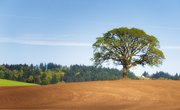
All birch trees are of the genus Betula, which is related to the beech and oak family of trees. The birches include some 50 species that naturally inhabit the cooler northern climates, many of them shrub-sized. Of the tree-sized birches, all are identified by the presence of a paper-like peeling bark. Depending upon the type of birch, the bark can be white, silver or variations of both, developing dark gray to black markings or horizontal streaks of gray as the tree ages; the bark on older trees is much darker than on young trees. Bark and other characteristics help tree enthusiasts identify birches and distinguish between species.
Identifying Marks & Ecological Role
Most birch leaves grow 2 to 3 inches long and have a characteristically oval leaf base and serrated or saw-toothed edges. Birch trees have both male and female flowers called “catkins” that appear on the same tree. Male catkins droop, are about 1 1/4 inch long, form in the fall and remain on the tree through the winter, never opening until late April or May. Female catkins make their appearance in the spring right along with the new tree shoots. They stand upright and grow up to 1 inch long. Female catkins elongate and form hanging catkins that contain hundreds of tiny seeds, which are scattered on the wind.
Comparatively short-lived trees, birches serve as important pioneer species of burned or otherwise disturbed areas, colonizing them early and enriching the soil as they die off and decay.
Downy Birch
Native to Eurasia, the downy birch has simple leaves characterized by a triangular shape with rounded corners and a very jagged leaf edge. The young twigs come covered with tiny hairs. The buds are prominent on the slender twigs and may be sticky. The young stems may be red, turning to white/silver with age. The grayish or white bark then develops markings of dark gray and black, making the tree trunk and bark much darker as the tree ages.
European White or Weeping Birch Silver Birch)
A graceful, weeping form is typical of the European weeping birch, very popular in landscaping for this profile. The youngest twigs, which drape at the ends of the branches, account for the weeping form of the tree. The leaves are deeply cut, giving the tree a lace-like appearance. The bark on the weeping birch turns white as the tree matures. The tree prefers full sun and its leaves, normally dark green, turn golden in the fall. Weeping birches bloom in the summer.
Paper Birch
The paper birch boasts the largest and (along with the Kenai birch) the most northerly range of North American birches. Full-grown trees range between 30 and 70 feet tall and tend to grow straight with round or pyramidal crowns. Paper birches often grow as a clump of three or more main trunks. Mature trees have a white, papery bark that peels away to reveal an attractive underside for both summer and winter landscapes.
References
- European Genetic Forest Resources Programme: Betula pubescens
- The Sibley Guide to Trees (David Allen Sibley)
About the Author
Ann Parks has been a freelance writer for 15 years and has been published in the "Houston Chronicle," the "Houston Business Journal," and a national book review magazine. In 12 years as a technical writer she was recognized as a distinguished contributor by the National Society for Technical Communications.
